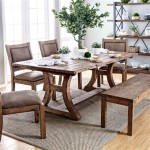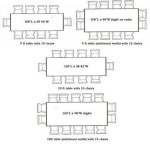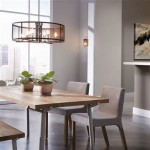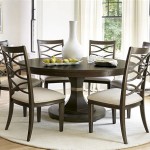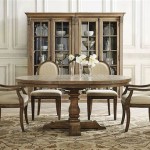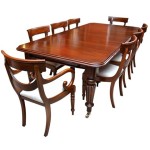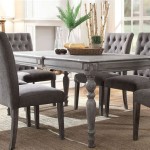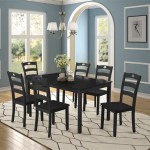The Enduring Appeal of Vintage Teak Dining Room Tables
Vintage teak dining room tables hold a unique position in the world of furniture, representing a blend of timeless design, exceptional durability, and inherent natural beauty. Their enduring popularity stems from the qualities of teak wood itself and the craftsmanship often associated with mid-century modern and Scandinavian furniture design. These tables are not merely functional pieces; they are statements of style and investments that can appreciate in value over time.
Teak, derived from the *Tectona grandis* tree, is a tropical hardwood renowned for its strength, water resistance, and rich golden-brown color. Its high oil content makes it naturally resistant to rot, decay, and insect infestation, properties that are especially crucial for furniture designed to withstand the rigors of daily use in a dining environment. This inherent durability contributes significantly to the longevity of vintage teak dining room tables, allowing them to retain their structural integrity and aesthetic appeal for decades with proper care.
Furthermore, vintage teak dining room tables often embody design principles that prioritize both form and function. Many were crafted during the mid-century modern era, a period characterized by clean lines, minimalist aesthetics, and a focus on practicality. These tables frequently feature simple, elegant shapes, often with gently tapered legs and smooth, unadorned surfaces. This understated design sensibility allows them to seamlessly integrate into a wide range of interior styles, from modern and contemporary to traditional and eclectic.
Teak's Unique Properties and their Impact on Furniture Longevity
The exceptional properties of teak are central to understanding the enduring appeal and longevity of vintage teak dining room tables. As previously noted, the high oil content of teak wood acts as a natural preservative, guarding against moisture damage and insect attacks. Unlike many other types of wood that require regular sealing and treatment to prevent deterioration, teak's natural oils provide a built-in protective barrier. This inherent resistance to the elements is particularly important for a dining table, which is frequently exposed to spills, condensation, and fluctuating humidity levels.
Beyond its resistance to decay, teak is also remarkably stable, exhibiting minimal warping or cracking over time. This stability is due to its dense grain structure and the slow growth rate of the trees from which it is harvested. This inherent stability ensures that vintage teak dining room tables maintain their structural integrity and appearance even after decades of use. The tabletop remains flat and even, the legs remain sturdy, and the joints remain tight, contributing to the overall durability and longevity of the piece.
The color of teak also plays a role in its desirability. Freshly milled teak exhibits a warm, golden-brown hue, but over time, and with exposure to sunlight, it develops a beautiful silvery-gray patina. This natural aging process enhances the character and charm of the wood, adding to its unique appeal. While some owners prefer to maintain the original golden-brown color through regular oiling, others embrace the natural graying process, allowing the table to develop a distinctive and weathered appearance. The beauty of teak lies in its ability to evolve and adapt to its environment, further contributing to its timeless quality.
The sustainability of teak sourcing is also a growing concern. While vintage tables predate many modern sustainability regulations, consumers considering the acquisition of a vintage teak dining room table may wish to investigate the provenance of the wood if possible. Reputable antique dealers should be able to provide information about the history and origin of the piece. Current regulations regarding teak harvesting emphasize responsible forestry practices to ensure the long-term availability of this valuable resource.
Design Characteristics of Vintage Teak Dining Room Tables
Vintage teak dining room tables often reflect the design sensibilities of the mid-century modern and Scandinavian movements. These styles are characterized by clean lines, functional forms, and a minimalist aesthetic. The tables typically feature simple geometric shapes, with a focus on practicality and usability. Elaborate carvings or ornate details are generally absent, allowing the natural beauty of the teak wood to take center stage.
One common design element is the use of tapered legs, often made from solid teak or other hardwoods. These legs provide stability and support while contributing to the table's overall sleek and elegant appearance. The legs may be attached directly to the tabletop or connected via a frame, depending on the specific design. The angle and shape of the legs can vary, but they typically exhibit a subtle, understated curve or taper.
Many vintage teak dining room tables are designed with extendable leaves, allowing them to accommodate larger gatherings. These leaves are often stored discreetly beneath the tabletop and can be easily deployed to increase the table's seating capacity. The extension mechanisms are typically simple and reliable, reflecting the emphasis on functionality and durability inherent in mid-century modern design. The extended portion maintains a seamless visual appearance, blending smoothly with the original tabletop surface.
The size and shape of vintage teak dining room tables vary depending on their intended use and the size of the dining room. Rectangular tables are the most common, but oval and round tables can also be found. The dimensions of the table should be carefully considered to ensure that it fits comfortably within the space and provides adequate seating for the desired number of guests. A table that is too large can overwhelm the room, while a table that is too small may feel cramped and inadequate.
The finish on vintage teak dining room tables can also vary, depending on the original manufacturing process and any subsequent refinishing or restoration. Most tables were originally finished with a clear lacquer or oil, which enhanced the natural beauty of the wood and provided a protective barrier against stains and scratches. Over time, this finish may have worn away or become damaged, requiring refinishing or restoration. Refinishing can restore the table to its original luster, but it is important to choose a finish that is appropriate for teak wood and that complements the table's overall design.
Care and Maintenance of Vintage Teak Dining Room Tables
Proper care and maintenance are essential for preserving the beauty and longevity of vintage teak dining room tables. While teak is naturally durable and resistant to damage, it is not impervious to wear and tear. Regular cleaning and occasional oiling can help to maintain its appearance and protect it from the elements.
Regular cleaning should be performed with a soft, damp cloth. Avoid using harsh chemicals or abrasive cleaners, as these can damage the finish and scratch the wood. For spills, blot the area immediately with a clean cloth to prevent staining. If a stain does occur, try using a mild soap and water solution to gently remove it. Avoid excessive scrubbing, as this can wear away the finish.
Oiling is recommended periodically to replenish the natural oils in the teak wood and to protect it from drying out. Teak oil is specifically formulated for use on teak furniture and can be purchased at most hardware stores. Apply the oil sparingly with a soft cloth, following the manufacturer's instructions. Allow the oil to soak into the wood for several hours, then wipe away any excess. Oiling not only enhances the appearance of the wood but also helps to prevent cracking and warping.
Protecting the table from direct sunlight is also important. Prolonged exposure to sunlight can cause the wood to fade and dry out. If the table is located near a window, consider using curtains or blinds to filter the sunlight. Additionally, avoid placing hot items directly on the tabletop, as this can cause heat damage. Use coasters and placemats to protect the surface from scratches, stains, and heat.
For tables that have been damaged or neglected, professional restoration may be necessary. A qualified furniture restorer can repair damaged veneer, fix loose joints, and refinish the tabletop to restore it to its original condition. Restoration can be a costly undertaking, but it can significantly enhance the value and longevity of the table.
When moving a vintage teak dining room table, it is important to lift it carefully to prevent damage. Avoid dragging the table across the floor, as this can scratch the legs and damage the floor. If the table is heavy, consider using furniture sliders or enlisting the help of others. Proper handling during transport can help to prevent costly repairs and ensure that the table remains in good condition for years to come.
By following these care and maintenance guidelines, owners can ensure that their vintage teak dining room tables remain beautiful and functional for generations. These tables are not only practical pieces of furniture but also treasured heirlooms that can be passed down through families.

Archive Dining Tables Vintage Modern Maine

Vintage Mid Century Teak Dining Table 4 Chair Set

Vintage Teak Dining Table And Chairs By Victor Wilkins For G Plan 1960s Set Of 5

Rejuvenation Vintage Mid Century Teak Dining Table 4 Chair Set

Vintage Extendable Teak Danish Dining Table By Ole Hald 1960 S Etsy

Archive Dining Tables Vintage Modern Maine

Vintage Danish Teak Dining Table And Chairs 1970s Set Of 7 For At Pamono

Midcentury Modern Vintage Danish Teak Dining Set Table 6 Chairs Aml

Rare 60s Niels O Møller J L Luxury Teak Dining Table Mid Century Modern Danish Design 70s Etsy

Danish Modern Faarup Mobelfabrik Koford Larsen Teak Dining Table Only No Chairs

